
The architectural award-winning Ata Rangi tasting room
Few New Zealand wineries command the reverence that Ata Rangi does, especially when it comes to Pinot Noir. Founded in 1980 by Clive Paton—one of Martinborough’s original winegrowing pioneers—Ata Rangi began as a bold experiment on a stony sheep paddock at the edge of the village. Clive sold his dairy herd to pursue a dream many thought mad at the time: crafting world-class wine in a region better known for beer and livestock.
The name Ata Rangi, meaning “dawn sky” or “new beginning” in te reo Māori, reflects both the optimism of its founding and the clarity of vision that has guided the winery ever since. Joined early on by his sister Alison Paton and winemaker Phyll Pattie (later his partner), the trio built Ata Rangi into one of the most respected Pinot Noir producers in the Southern Hemisphere. Their use of the legendary “gumboot clone”—allegedly smuggled from Domaine de la Romanée-Conti by an enterprising Kiwi Rugby player, confiscated at the border and nurtured through quarantine by Malcolm Abel—helped shape the house style: elegant, structured, and deeply expressive of Martinborough’s unique terroir.
Today, winemaking is led by Helen Masters, whose tenure since the early 2000s has seen Ata Rangi’s reputation soar even higher. Building on base study in fermentation and food processing, she has developed deep expertise in viticulture as well as winemaking. With profound respect for vintage and site expression with minimal intervention, Helen has refined the house style to focus on elegance, energy, and longevity. Her work has not gone unnoticed: in 2019, she was named New Zealand Winemaker of the Year by Gourmet Traveller WINE, a testament to her thoughtful, terroir-driven approach and her role in shaping the identity of modern Martinborough Pinot Noir. Under her stewardship, Ata Rangi continues to balance tradition with quiet innovation, crafting wines that speak of place, season, and the people behind them. In 2010, Ata Rangi Pinot Noir was awarded the rare honour of being named a Tipuranga Teitei o Aotearoa—a “Grand Cru of New Zealand”—recognizing its consistent excellence and profound expression of site.
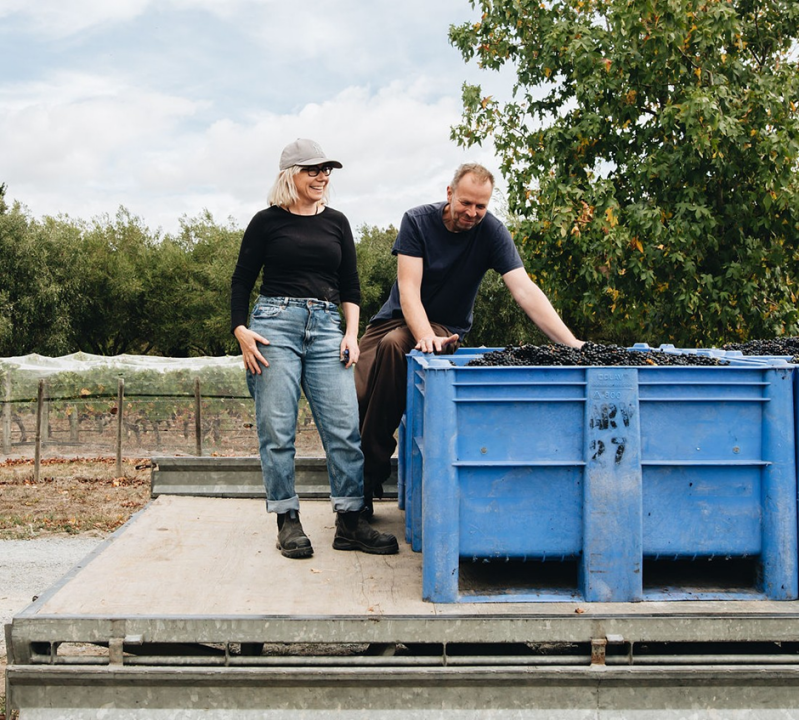
Winemaker Helen Masters with Viticulturist Ian Ewart
Vineyard manager Ian Ewart continues the legacy of meticulous viticulture, ensuring each vintage reflects the land’s quiet power and seasonal nuance. Ata Rangi’s home vineyards have been certified organic since 2014, a reflection of the team’s commitment to sustainability and soil health. Ian leads a dedicated crew who know each block intimately—including my own wife, Suchitta, who works on his team. Their work in the vines is the foundation of everything that follows in the winery: a careful choreography of pruning, canopy management, and harvest timing that allows each vintage to tell its own story.
The Martinborough Terrace offers a uniquely challenging yet rewarding environment for Pinot Noir, defined by its dry climate, free-draining soils, and persistent winds that shape both vine and wine.
Situated in a rain shadow cast by the Tararua and Rimutaka Ranges, the terrace is one of the driest regions in New Zealand’s North Island, with low annual rainfall and long, reliably dry autumns—ideal for slow, even ripening. The soils are ancient alluvial gravels overlaid with silt loam, providing excellent drainage and encouraging deep root systems that promote vine resilience and site expression. But it’s the relentless north-westerly winds that give Martinborough Pinot its distinctive edge: these winds stress the vines just enough to thicken grape skins, concentrating tannins and phenolics while reducing disease pressure. The long temperate growing season ensures slow, even ripening of the tannins in the grape skins and seeds and retention of acidity. The result is Pinot Noir with fine structure, vibrant acidity, lifted aromatics, and remarkable aging potential—a style that has become synonymous with the region’s best producers.
Ata Rangi farms approximately 32 hectares across 14 vineyard blocks clustered around the Martinborough Terrace.
These sites share the classic Martinborough Terrace soil profile: 300–600 mm of shallow silt-loam over deep alluvial gravels, ideal for Pinot Noir. While not all 32 hectares are contiguous, with the exception of the Masters Vineyard on Lake Ferry Road, they are all situated on or adjacent to the Terrace, forming a mosaic of carefully managed parcels that reflect subtle variations in soil and microclimate.
Ata Rangi’s exploration of single-vineyard Pinot Noir began with the McCrone Vineyard, first bottled separately in 2006. The site was first purchased by Don and Carroll McCrone and planted with technical and physical assistance in collaboration with Ata Rangi in 2001. It was purchased from the McCrones by Ata Rangi in 2012. The McCrone vineyard lies just west of the home vineyard and features heavier, clay-influenced soils that yield a darker-fruited, more brooding expression of Pinot Noir. In recent years, the range has expanded to include Kotinga, a stony, wind-exposed site on the Martinborough Terrace that delivers lifted aromatics and fine structure, and Masters, a more southerly vineyard on Lake Ferry Road, where cooler conditions and deeper soils produce a taut, savoury style with distinct mineral drive. These single-vineyard wines are not about hierarchy, but about site transparency—each one a study in how soil, aspect, and microclimate shape the voice of Pinot Noir in Martinborough.
Yet for all their individuality, it’s the Ata Rangi Pinot Noir—the original blend—that remains the historic benchmark and, for me, still the most complete expression of the estate’s philosophy. It draws from the oldest vines, the deepest gravels, and the most seasoned intuition. Year after year, it captures the essence of the Martinborough Terrace: structure without weight, perfume without excess, and a quiet confidence that speaks of time, place, and people. It’s a wine that rewards patience, invites reflection, and—at least in my cellar—holds pride of place.
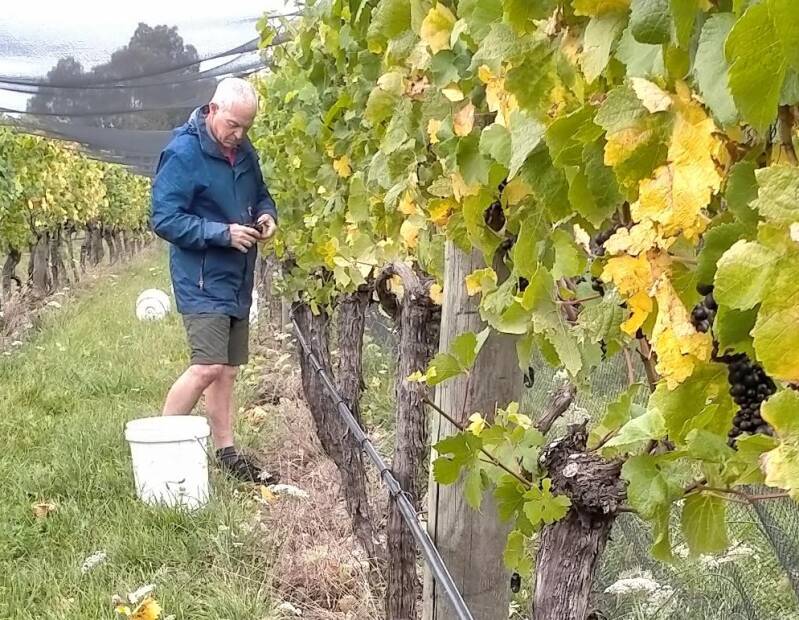
The author examines a bunch of Ata Rangi clone 5 Pinot Noir during the March 2025 harvest.
Strangely enough, my first Ata Rangi encounter and meeting Clive at his original “cellar door” in 1988 was not with Pinot Noir but with the recently released 1986 vintage of their Bordeaux meets Rhone blend Célèbre. I left New Zealand for Australia at the end of that year, not to return until 2002, when I was quick to re-introduce myself and their 2001 Pinot Noir which features in this vertical tasting was my first cellar purchase that year. I left New Zealand again in 2005, this time for Singapore and then Thailand and Myanmar, but since my return in 2015, Ata Rangi Pinot Noir has been an annual cellar purchase from the 2013 vintage. I was blessed also to acquire some older vintages from the winery as library releases, including the 2009, 2010, and 2012. Both the 1991 and 2001 vintages in this tasting were acquired at wine auctions, all sourced from temperature controlled private cellars. The 2005 was supplied by Helen Masters.
My almost monthly wine tastings, attended by various wine enthusiasts and local winemakers have run in our home for about three years now, but few have been met with such excitement and anticipation. Helen had kindly offered to host this one and provide lunch at her home, and together with husband Ben, clearly demonstrated their culinary skills matched her winemaking prowess. The tasting order was oldest to youngest and as is our custom, were sampled first before the lunch and then again with the food. Only the 1991 and 2001 were under cork as Ata Rangi changed to screwcap closures in 2002. The 1991 cork was pristine, sadly the 2001 was not and disintegrated on opening, requiring decanting and straining. None of the other wines were decanted except for the 2005 poured for lunch. All of the wines in this lineup were bottled unfined and unfiltered.

Lunch was delicious!
Apart from the expected progression from tertiary to primary flavours, a gradual increase in concentration was evident with increasing wine age and perhaps growing winemaking confidence. The early wines utilised a modest 10% whole bunch proportions in the ferment but this was progressively dialed up from 2012 to reach a zenith in 2017 from which point about 40% whole bunch inclusion has been typical and was evident in the aromatics, as well as in greater structural tension and silkier tannins.
While every wine spoke of the vintage, there was a thematic similarity from 2009-2013, again from 2014-2016, with a sui generis 2017 followed by the magnificent 2020 and 2021.
I am not a wine critic and even Masters of Wine taste differently. The following notes solely reflect my personal appreciation. Vintage notes are mostly paraphrased from those provided by Helen.
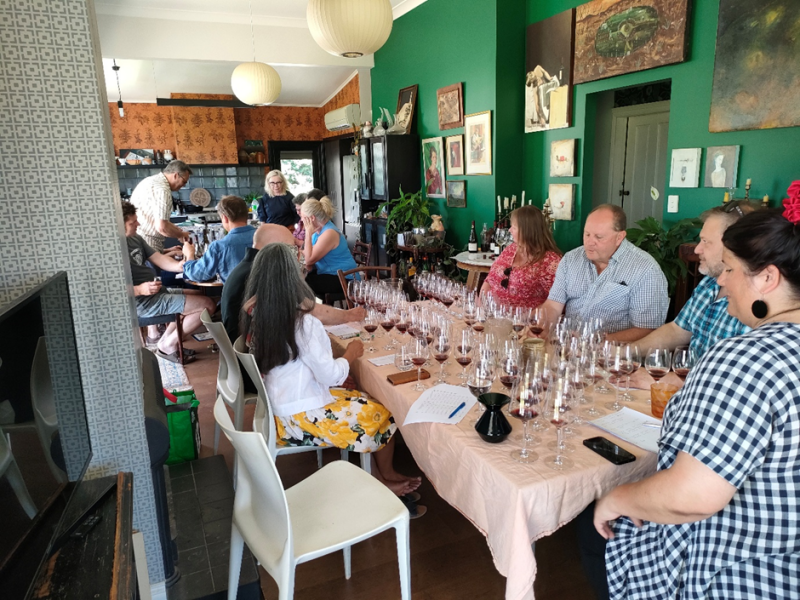
1991
The 1991 vintage in Martinborough was a challenging one with early cool conditions and high rainfall, redeemed by an exceptional warm, dry autumn which allowed the grapes to fully ripen in good condition for harvest, overall leading to leaner, more structured Pinot Noirs with intensity of flavour and excellent longevity. The wine was a stunning demonstration of the age-ability of these wines even from younger vines! Pale ruby-garnet in the glass with a lovely fragrance of pot-pourri, sous-bois and red cherry. The fruit was beautifully alive on the palate with a perfect balance of acidity and gentle tannin, and a long fine finish, it is hard to imagine how a 34-year-old Pinot Noir could be better!
2001
The only disappointment due to the bad cork from a vintage that had so much promise, starting with a cool and occasionally frosty Spring followed by dry, windy but relatively cool Summer that saw excellent fruit set. This was succeeded by a dry and warm autumn that produced ripe grapes with bright flavours and excellent acidity. Garnet and browning in the glass with very tertiary aromas and slightly oxidative aromas of cooked cherry fruit and old compost, it was still palatable but very tired. Sad proof of the old adage "under cork there are no good wines, only good bottles", and this was not one of them. How good this might have been with a decent cork!
2005
Not part of the planned lineup but provided in a Magnum by Helen for lunch. From a vintage that must be described as challenging with a cool November and December leading to poor flowering and low fruit set. A warm mid-summer was followed by March rainfall requiring careful canopy management before a settled April harvest marked by small berries and bunches. Ruby in the glass, surprisingly dark for its age, doubtless due to the small berry size, with aromas of dark cherry, rose, mushrooms and forest floor. On the palate quite sweet dark cherry, forest berry, rhubarb and sous-bois flavours with some spicy notes, nicely balanced but still fresh acidity, firm tannins and a long moreish finish.

Helen pouring the 2005 for lunch
2009
Overall a very warm vintage characterised by ripe seeds and tannins, commencing with a settled Spring that saw quick even flowering and excellent fruit set, requiring some thinning of bunch numbers. A mild mid-Summer saw a heat spike in late January and then a cooler and occasionally rainy February that delayed the expected early harvest to the second half of a warm, settled March. Bright ruby in the glass with garnet edges. Aromas of dark cherry, bramble, rose and some distinct savoury and nutty notes. A gentle and supple entry builds to a more powerful palate of sweet cherry and bramble fruit, with quite dominant savoury forest floor and herb elements tinged with sweet baking spice and a gentle minerality, particularly on the longish finish. Poised, balanced and sophisticated, at or close to its peak. One of my favourites, match with a mushroom risotto.
2010
As so often in Martinborough, a vintage of two halves. A slow cool Spring and Summer with late flowering redeemed by a perfect “Indian summer” autumn of warm sunny days and cool nights through to mid-May, and later harvest than usual but pristine fruit. In the glass, darker ruby than the 2009, with lovely floral notes of violets and rose overlaying the red cherry fruit with supporting sous-bois, thyme and crushed limestone. The palate is elegant and perfectly balanced, with dark cherry and cranberry fruit, lovely freshness and a long dry complex finish. Delicious now but plenty of life left!
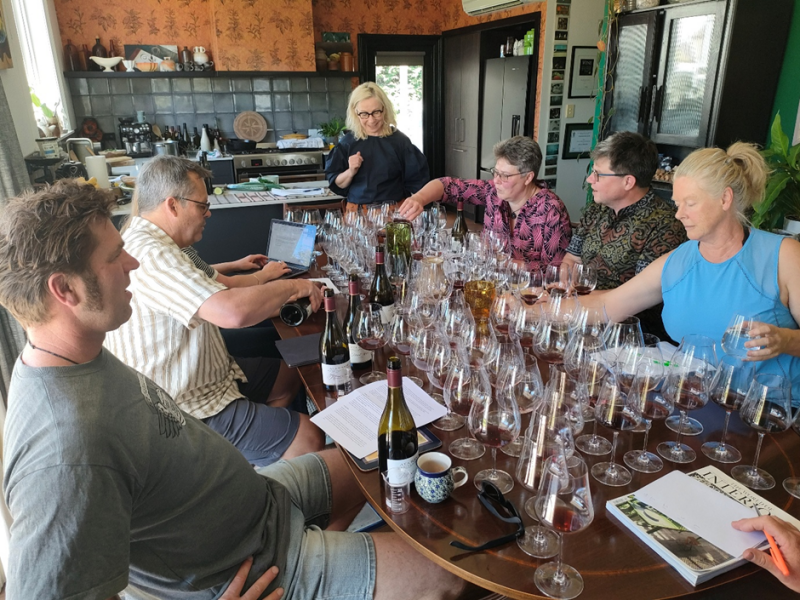
2012
From a cool and wet vintage with more than usual rain but followed by a classic “Indian summer” autumn with dry warm sunny days and cool nights through to mid-May. This resulted in a late harvest as for 2010, that ensured phenolic ripeness and clean fruit. Another demonstration of how more difficult vintages sometimes produce outstanding wines in the hands of a skilled winemaker! A step up to 30% from the earlier 10% whole bunches. Deeper ruby in the glass and with distinct spicy notes overlaying the bright cherry and raspberry fruit aromas, tinged with pot-pourri and forest floor. The tart cherry and raspberry fruit on the palate has an increased richness and depth that I loved with a blood orange and peppery spice edge and perfect balance of acidity and tannin, a tinge of smoke and a vibrant finish. Another favourite that surprised – I was expecting lean.
2013
This was a vaunted warm vintage across New Zealand, characterised in Martinborough by a mild settled Spring flowering, dry, warm December, cooler January that slowed ripening sugar ripening, a bit of rain in February to refresh the vines, followed by good March weather delivering phenolic ripeness and a cool, dry April harvest with pristine fruit. Made with 30% whole bunches and aged 11 months in French oak, 30% new. In the glass bright ruby with aromas of red and black cherry, lavender and forest floor. On the plate this has a depth of fruit, quite rich, spicy dark cherry, tending plum with firm tannins and vibrant acidity adding structure, finishing rich and generous. Another step up in concentration and a decade still ahead of it at least. Sadly, I have only one bottle left.
2014
The key feature of this vintage was early bud break, but a short growing season did not materialise thanks to some cool weather that allowed good hang time and slower ripening with very few days over 26 degrees. Nonetheless picking was early. In the glass darker ruby than the 2013 with aromas of violets, ripe Dawson cherries and hint of blueberry(?), leaf mould and lapsang souchong. The palate is rich and sweet fruited with cherry and plum flavours, smoke, leather and spice, still quite primary with fresh acidity and fine tannins, finishing long and rich. Nowhere near its peak yet.
2015
A typically unsettled Martinborough Spring resulted in low yields and small berries. Summer months were very dry and vines were stressed by the drought and wind. Relief came with some late summer showers refreshing the vines and allowing proper ripening through a settled Autumn, achieving phenolic ripeness at lower sugar levels. Bright ruby in the glass with lifted aromas of lavender, rose, red cherry, bramble, sous-bois and some spice too. The palate is still tight with firm tannins, but sweet cherry and bramble fruit, a bit of cocoa and cola, juicy and long.
2016
A good Spring saw perfect budding, flowering and fruit set with even bunches and bunch size well distributed on the canes. Overall Growing Degree Days were marginally above average but February was the hottest since 1998, bringing early phenolic ripening enabling picking at lower sugar levels. The key feature of early Autum was the relative absence of wind but with low rainfall the overall impact was positive with less vine stress and a healthy crop. Bright ruby in the glass with cherry, plum and forest floor aromas touched with baking spice. The palate had excellent fruit weight with dark cherry, cranberry and plum flavours, spice and mushroom, the acidity just a little crunchy, the fine tannins still firm and the finish long.
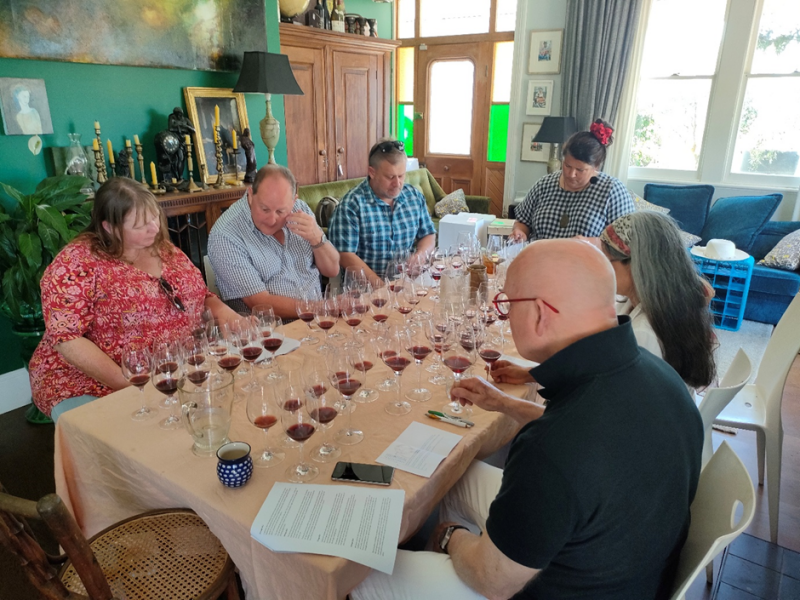
2017
Another great wine from a challenging vintage. A cooler, more overcast growing season that ended with unseasonal rain. However lower yields saw phenolic ripeness at lower sugar levels for harvest. Careful picking and sorting was important with late season rain-induced disease pressure. This was another step up in whole bunch to 40%. Bright ruby with a distinct herbal edged sour cherry nose that almost reminded me of Etna Rosso, some sandalwood and pot pourri too. On the palate this is so pretty with juicy red fruit, spice, dried herbs and dried mushroom flavours, beautifully balanced fresh acidity and fine silky tannins, finishing long with that sour cherry edge. Delicious now but better in another decade and will last another two!
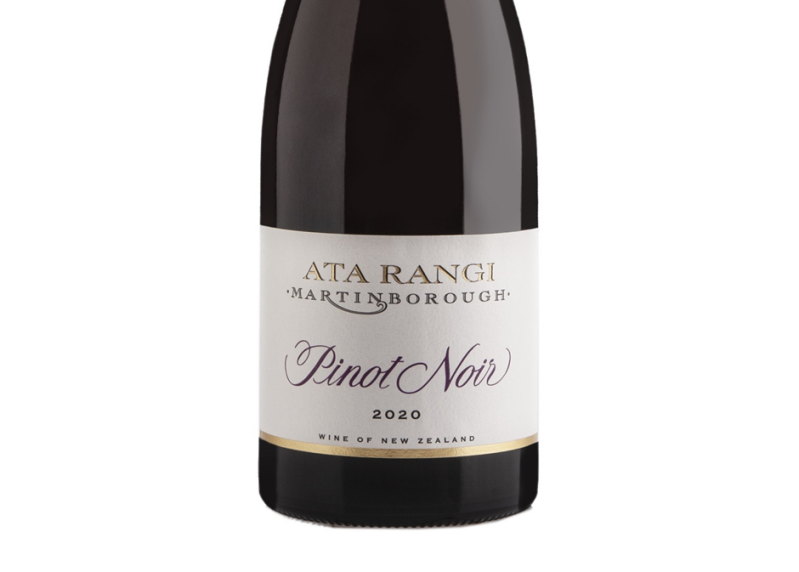
2020
Considered one of NZ’s great vintages but complicated by Covid restrictions during harvest. The key feature was no extremes of any kind, moderately dry, an Indian summer that did see a short period of heavy rain in late March but most of the fruit was in by then and what was left remained in good condition. Medium ruby in the glass with a distinct ripe Dawson cherry aroma, hints of rose and violets, smoky tea leaves and dried herbs. Perfectly poised between openness and structure, the concentrated flavours of dark cherry, raspberry and dried herbs with a hint of cedary oak are supported by juicy acidity and fine but firm tannins, the long finish is mineral edged with a touch of ironstone and iodine.
2021
Another, not uncommon vintage of two halves with an erratic Spring of warm days punctuated by frost and a cool wet November that saw poor flowering and fruit set resulting in small bunches, An uneven Summer resulted in small berries on those bunches followed by late summer winds that further reduced berry size. A long dry and warm Autumn saw clean ripe and intensely flavoured fruit, harvested with a higher than usual skin to juice ratio that required careful management of extraction – achieved at Ata Rangi with aplomb! Darker ruby in the glass with more raspberry and even blackberry aromas overlaying Dawson cherry with violets, spice and a hint of orange peel. On the palate quite concentrated raspberry and blackberry fruits are supported by fine firm tannins, fresh acidity, and a touch of lapsang souchong. The finish is powerful, long and layered.
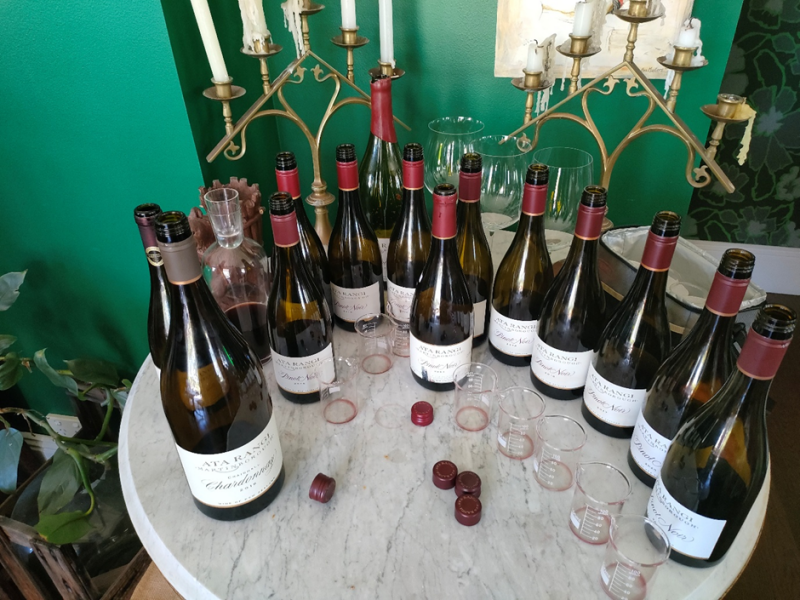
………………………………………………………………………………………………………………………..
All in all, a singularly impressive tasting illustrating both consistency and progression, whilst reflecting the vintage. For me personally, the defining characteristic of Ata Rangi Pinot Noir is its proven age-ability and this tasting was a resplendent demonstration.
For another account of the same event by WSET Diploma qualified wine writer Joelle Thompson see Three decades in the glass - Ata Rangi Pinot Noir | Joelle Thomson Wine Writer & Author.
If you enjoyed this weekly blog, you can subscribe for free using the contact form, or just email info@wineinsights.org. To see all my daily content follow me on Facebook.
#Martinborough Pinot Noir; #Ata Rangi Pinot Noir; #Ata Rangi Pinot Noir Reviews; #Winetasting Martinborough;
Add comment
Comments